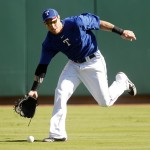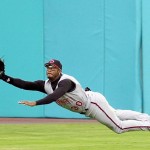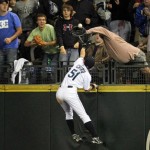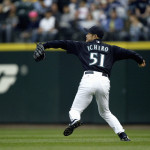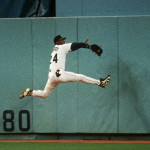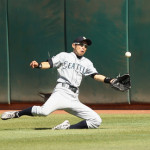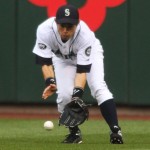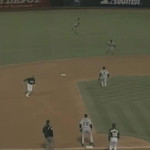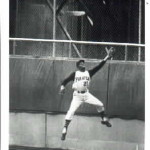by John Paciorek
“Fielding”
Human bodies are not stick figures, animated without rhythm and reason. They are characters whose minds think and move them in more than one dimension to incorporate and facilitate function. Things contrived are never really simple; but knowledge of the intricate, and the understanding of elements that sustain a natural order, make it possible to simplify/clarify that which appears complex/difficult.
The Principle of Fielding is intended to awaken in every advocate of the game an easy and simple means to facilitate the proper mechanics necessary to improve his/her play. Simplicity is the integration and coordination of life’s infinite array of variables within the realm of understanding. By gaining an understanding of the minute details of the specific movements involved in the specialized aspects of “fielding,” an amateur athlete can gain a greater appreciation for what it takes to possibly emulate the performances of an outstanding player. 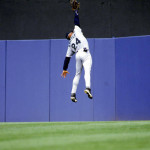
The only way to describe the best of ball-players at his position is that “he makes it look simple.” Although it is not really simple, abiding by a strict discipline of simple mechanics, the best players have perfected the techniques for their particular positions through arduous, repetitive labor, from which the human physical endeavor eventually appears effortless and instinctive.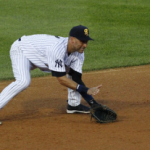
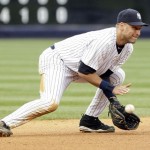
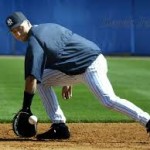
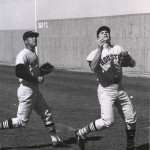
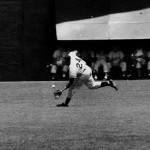

Outfield Play
What type of player plays in the outfield? What are the qualifications for being a good outfielder? First, if a player is left-handed, and a fast runner, he/she is probably a good prospect for outfield! Fast, right-handed people are also good prospects for outfield positions; but they can also play infield. You don’t usually want to “waste” a speedy person at First Base, unless he has extraordinary skill there, or limited throwing capacity.
An outfielder must be able to catch balls that are hit high in the air; and he must also catch them while he is running at full speed. So, if a player is a fast runner, and can catch fly-balls and “line-drives” while running full speed, and has a “good-arm,” he has a chance to become a very good outfielder, maybe a great one. 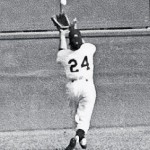
Everyone who is a professional ball-player, and is designated as an outfielder, has good speed, a “good arm,” and can catch balls that are hit in the air (as well as potential to hit for average or power). 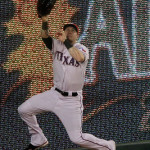 The subtle differences, that distinguish the great outfielders from the good ones, have a lot to do with certain physical attributes, such as arm strength and accuracy, as well as running speed, and a highly productive offensive capability. But, the most-subtle characteristic that distinguishes the “greatest” from the “pack” is an intangible element resident in individual “temperament.”
The subtle differences, that distinguish the great outfielders from the good ones, have a lot to do with certain physical attributes, such as arm strength and accuracy, as well as running speed, and a highly productive offensive capability. But, the most-subtle characteristic that distinguishes the “greatest” from the “pack” is an intangible element resident in individual “temperament.”
The Outfield can be a lonely, boring place for a mind that lacks a special creativity. A player who always needs to be closer to the “action,” whose sense of alertness can be stimulated only by the prospect of imminent responsibility, would be better suited for “infield,” where fielding opportunities are more profuse. An outfielder doesn’t get that many chances during the course of a nine-inning game, so he can’t afford to miss “any” opportunity to help his team.
An outfielder doesn’t get that many chances during the course of a nine-inning game, so he can’t afford to miss “any” opportunity to help his team.
Selflessness is a key component to defining the ideal “outfielder-temperament.” He cannot hesitate to expend his energy, in any situation, even when the play is obviously not within his immediate vicinity. It is naturally expected of infielders to be under constant anticipation, when a ball is played, because of the close proximity to both the ball and the base runners. But the expenditure of energy by infielders is minimal because of the close proximity, as well as the highly motivating “imminent responsibility.”
When a ball is hit to right field, most people would think that there wouldn’t be anything for the left-fielder to do in that situation. Even in a “Big-League” game, a spectator will very seldom see the left-fielder do anything, unless that fielder happens to be one of a small percentage of players classified as “a-great-one.” Then the observer will have the opportunity to witness the creative response that characterizes the unique attitude of a great outfielder.
In anticipation of the slightest chance that a mishap could occur, the left-fielder races toward the infield and positions himself in line with the throw coming to second base from the right fielder. Maybe once in 200 chances will he be involved in an errant play, but he still responds in the same manner. It would be unconscionable that a mishap should occur and he didn’t back-up the play.
On every ground ball to third base or short-stop, the “great” right-fielder is always racing toward the first base dugout hoping to recover any errant throw that might get by the first base-man, to prevent an extra base for the runner. It doesn’t happen often, but when it does the “great one” is always ready.
To the mind of every “great” outfielder there is something important to do on every play. It has been witnessed that, on a drag bunt toward third base with a fast runner on first, while the first and third basemen were charging, and shortstop covering second, that an ever-hustling left-fielder sprinted to third base and received credit for a put-out on the runner racing around second to third base, thinking no one was covering the bag.
Anything can happen in Baseball, and the ever-thinking, creative mind of the “great” outfielder is always on the alert that “it” doesn’t happen “on his watch.” The baseball theatre is overflowing with dramatic possibilities for every situation. The “great” impresario of the outfield relishes in new and unrehearsed circumstances while the non-energetic “daisy-picker” wallows in the mental miasma of tacit mediocrity. Thus the outfield is only a dull place for the dull mind.
To reiterate, selflessness, high energy, and ingenuity characterize the excellent outfielder. Many are called, but few are chosen, or rather willing, to become supreme in that domain. Most would presume that all “that” work would have a detrimental effect on their hitting, so they opt to merely get the job done “well-enough” so as not to embarrass themselves.
Every good team has at least one great outfielder. A great team usually has more.
How and where does someone become a great outfielder? The only place to prepare to be “great” is on the practice field, both before the season begins and in pre-game batting practice during the season. Ideally the “Great One” had the good fortune of being trained properly from his youth by a knowledgeable coach. Rare!
Although the primary tool to outfield greatness is one’s mental attitude, he still has to apply himself physically to accomplish the tasks for which he is acclaimed. Two specific and crucial tasks that every outfielder tries to accomplish and for which the “great one” is most consistent in performing are: throwing out runners trying to advance to another base, and making the great running catch that everyone in the ball-park thought was a sure hit.
Both situations have a common element that all outfielders aspire to develop, but only the great ones seem to have perfected, that of getting the “jump on the ball.” Some of the fastest runners in Baseball could hardly be classified as “great ones” even though their speed certainly would have qualified them as eligible prospects.
“The man who gets to the ball the fastest is not always the fastest runner.” Getting the “jump” is a skill that takes practice. The only way to perfect this sensitive skill is through patient and “perfect” practice. (You can’t do it by merely having someone hit “fungoes” to you.) The prospective “great one” plays his position and fields balls off the bat that have been pitched, either in batting practice or in games.
Batting practice allows for more chances in shorter time. Simulated games allow for a truer sense of reaction to the pitch thrown and batter’s response. The most astute learner will apply himself with the same intensity in batting practice as in the game until this procedure becomes more than a continuous learning situation, but an established insight and infallible instinct.
What exactly is “getting the jump on the ball”? The answer is, “. . . the quickest-possible physical response by the fielder to the ball hit off the bat.” Such response is heightened by the fielder’s pre-disposed ability to “read” the type and direction of the pitch as well as the disposition of the batter to hit such pitch.
The greatest of the “great” have the uncanny knack for “taking off” seemingly before the ball is hit. To catch the ball after having gotten the great jump is a marvelous feat to behold. But the added dimension of running, catching, and then throwing a runner out at second, third, or home-plate livens any arena with gasps and exhilarating chants from awestruck fans and colleagues alike.
When a runner is safe or out “by a hair,” there is usually one reason, the outfielder did or did not get to the ball as fast as he could have. All things being equal (all outfielders having the same speed, strength and accuracy of arm), there is no doubt that the time in which the fielder got to the ball and scooped, positioned himself, and threw within the same continuous motion determined the outcome of the play.
An outfielder is not born with this type of talent. He can only acquire it through hard work. In batting practice and game-situations, he must vigorously approach every ball hit to him through the infield as one in which he “must” throw the runner out at the “plate.” He cannot practice starting fast then slowing down as he approaches the ball.
Only “Perfect” practice makes “Perfect.” He must strive to attain the most proficient “knack” for “scooping” at full speed, then manipulate his body to be able to throw powerfully and accurately (he doesn’t have to throw the ball each time—just get the body in position to throw).
Half-hearted efforts will never help to attain the full status of “the great one.” It had been witnessed that a “once great” outfielder who, for all extensive purposes, had lost a major portion of his arm strength but was a master at charging ground balls hit through the infield with a runner at second base, was so adept at this facet of his trade that, since he was so close to the infield when he picked up the ball, no third base coach felt confident to send the runner, even though “they” all knew he couldn’t throw.
The beauty of Baseball is that anyone can develop any of the specific skills of the game through hard work. And mental adroitness can enhance the sense of greatness even in those individuals without the best of natural ability.
Coming soon: Infield Play!
